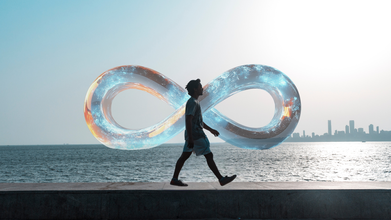- Health Conditions A-Z
- Health & Wellness
- Nutrition
- Fitness
- Health News
- Ayurveda
- Videos
- Medicine A-Z
- Parenting
- Web Stories
Does Penis Continue To Grow After Puberty?

Credit: Canva
Testosterone is a male sex hormone that plays a crucial role in metabolism, influencing various aspects of health, including libido and sperm production. While testosterone is essential during puberty for penis growth and testicle development, its effects on size plateau once a man reaches sexual maturity.
During puberty, testosterone surges dramatically, driving the growth of male sexual organs. It is during this time that the characteristics like libido, penis and testicles develop. This "blast" of testosterone, typically ends by the mid to late teenage years. Dr Paul Turek, a reproductive urologist, speaking to Men's Health, said, "Fertility is achieved as the testicles and penis increase to adult size during this phase."
Penis Doesn't Continue To Grow After Puberty
Once testosterone levels stabilize after puberty, the sexual development of the penis is complete. The final size of the penis is primarily determined by genetics. That implies you are already born with a penis size. Even if testosterone levels rise later in life, they won't influence penis size. Studies, such as one from the University of Utah School of Medicine, confirm that stretched penile length in adult men is not linked to testosterone levels. Additionally, the Kinsey Institute highlights that the penis is made of spongy tissue, not muscle, which means it cannot be "built up" through exercises or external methods.
Beware Of Testosterone Supplements
While testosterone is essential for sexual health, artificially increasing testosterone levels through supplements can be harmful. Many products promising to enhance penis size are ineffective and potentially dangerous. According to data from Harvard Medical School, more than the required levels of testosteronecan trigger health issues like low sperm count, heart damage, high blood pressure, mood swings, and more.
Penis Size Has Increased Globally
Interestingly, a Stanford University study found that the average erect penis length has increased by 24% worldwide over the past three decades. However, researchers noted this change isn't due to rising testosterone levels—in fact, testosterone levels have declined in many populations. Instead, environmental factors like pollution may play a role, though more research is needed to understand this phenomenon.
It’s natural to be curious about size, but experts emphasize that function is far more important. Health experts advise men to seek medical attention if they notice changes in appearance, such as spots, bumps, or curvatures, or if there are functional concerns. Addressing issues early not only ensures appropriate treatment but also alleviates unnecessary stress about potential problems.
So besides the shape, many different things can affect penis health. The list includes:
your ability to urinate comfortably
your ability to get or maintain an erection
your fertility
In addition, having a good penis health also means not getting infected from sexually transmitted diseases and also being free from penile cancer. One of the main factors that influence penis is hygiene, besides, age, sexual practices amongst others. Therefore, practicing good hygiene is essential for your health. You must wash your penis and groin area frequency to keep it clean and free of diseases.
8 Pickleball Warm-Up Exercises To Avoid Injuries, According To Expert

Credits: Canva and Instagram
Pickleball and padel, a sport that has gained momentum across India, is changing everyone's lives and helping people stay fit and active. However, while the game has gained many enthusiasts, fitness experts are also warning that enthusiasm without preparation can come at a cost. As many are reporting sports-related injuries, especially while playing pickleball. Luke Coutinho, lifestyle guru and holistic wellness expert in his Instagram video claims that he has seen a surge in knee, elbow, and lower back injuries linked to the sport.
“Pickle and paddle are two of the fastest-growing sports across our country right now, great for longevity, hand-eye coordination, and overall fitness,” says Coutinho. “But what’s equally important is knowing how to look after your knees, glutes, and elbows.”
Also Read: The Ozempic 'Trick' Could Cause More Harm For Non-Diabetic And Fit People, According To Doctors
According to him, just five minutes of targeted warm-up can dramatically lower the risk of injury. Here are the eight quick exercises Coutinho recommends before every game.
Wall Sit Toe Raises
You can start this exercise by leaning against a wall, sliding down until your thighs are parallel to the ground. Imagine as if you are sitting on an invisible chair. Keep your back as flat as you can against the wall. Coutinho says that this will "protect your knees and prevent shin splints."
How to do it:
- Hold this position and lift your toes upward while keeping your heels on the ground.
- Lower them back down slowly.
Why it helps: Strengthens the muscles in your shins and stabilizes the knees, helping prevent shin splints and knee strain.
Wall Sit Calf Raises
Coutinho suggests that you can follow up by this exercise. You can start from the same wall-sit position. This variation focuses on the calves and ankles.
How to do it:
- Keep your back flat against the wall, feet shoulder-width apart.
- Lift your heels up as high as possible, balancing on your toes.
- Slowly lower and repeat.
Why it helps: Builds ankle strength and lower leg stability, Coutinho suggests that it is the key for all those quick lateral pickleball movements.
Wall Knee Extensions
- Stay in the wall sit and extend one leg straight out in front of you.
- Hold for two seconds, then switch legs.
"It engages your quadriceps and enhances knee stability, reducing the risk of ligament tears," he points out.
Dynamic Lunges with Overhead Reach
While lunges are a great way to ensure mobility and flexibility, a little bit of modification could lead to a full-body stretch, along with balance training.
How to do it:
- Step forward into a lunge, keeping your front knee above your ankle.
- Raise both arms overhead as you lower your body.
- Push back to starting position and switch sides.
Why it helps: Opens your hips and chest while activating major leg muscles, prepping your core for rotational movements during play.
Mini Band Side Walks
How to do it:
- Place a resistance band just above your knees.
- Bend slightly at your hips and knees, then step sideways.
- Take 10 steps in one direction, then back.
Why it helps: Strengthens the glutes and prevents the knees from collapsing inward during sudden lateral shifts.
High Knees
This is probably the easiest, and one of the most common exercises anyone will encounter, especially while playing sports. It is a great way to warm up or cool down your body after a strenuous workout.
How to do it:
- Start by jogging in place, and bring your knees high, towards your chest.
Why it helps: It improves agility, coordination, and cardiovascular readiness before fast-paced rallies.
Knee Side Raises
How to do it:
- Stand upright, lift one knee out to the side, hold briefly, and lower it down.
- Repeat on the other side.
Why it helps: Builds lateral hip strength and enhances balance, crucial for sidesteps and quick turns.
Kickbacks
How to do it:
- Stand tall, kick one leg straight back without arching your back.
- Engage your glutes and hamstrings as you lift.
Why it helps: Activates the glutes and hamstrings, adding power to your movements and reducing lower back strain.
“Do 10 reps on each side, and you’re game-ready, explosive and injury-proof,” Coutinho says. “Looking after your health to prevent injury is the first step toward holistic wellness and longevity.” As he rightly says, "These warm-ups aren't optional, they are essential."
The Ozempic 'Trick' Could Cause More Harm For Non-Diabetic And Fit People, According To Doctors

Credits: Canva
Ever since fat loss jabs hit the market, including Ozempic, Mounjaro and Wegovy, gym enthusiasts and slim people are also turning to these popular weight loss drugs to enhance their physique. However, experts are sounding the alarm - they are warning that for those without obesity or diabetes, the risks outweigh the rewards.
The Rise of 'Fit' People Using Fat-burning Jabs
People who are already leading active lives are also reaching out for medications designed for obese people, especially those who want to crash diets before holidays, body builders and gym regulars. They have said that these drugs have helped them shed the "last few pounds" and sculpt leaner physiques easily.
The Sun reported that in bodybuilding, the phase of losing fat to highlight muscle definition is called "cutting". For some, GLP-1 drugs have become the shortcut to achieve that. However, UK's Medicines and Healthcare products Regulatory Agency (MHRA) has warned against using these jabs for the same.
Doctors have time and again cautioned against its use for non diabetic or obese persons, and highlighted side effects like nausea, fatigue, dehydration, and muscle loss.
Read: How To Identify A Counterfeit Ozempic? Look For These Signs, Details Inside
It Is Not A Shortcut
Dr Amos Ogunkoya, GP and sports medicine specialist, says and is as reported by The Sun, “Using weight-loss jabs when you already have low body fat is not a good idea. These medications slow digestion and suppress appetite, which can quickly lead to dehydration, fatigue, or even muscle loss in people with low energy reserves.”
He adds that extreme calorie restriction combined with low fat stores may trigger hormonal imbalances, depression, and anxiety. “In short, it’s not a shortcut, it’s a risk,” he warns.
Experts are also worried about the trend, which may have a log lasting impact on vulnerable people, especially those living with eating disorder. Dr Donald Grant, Senior Clinical Advisor at The Independent Pharmacy, as reported by The Sun, says many fitness enthusiasts are mixing GLP-1 drugs with performance-enhancing substances and restrictive diets, a combination with unknown risks.
“These medications were never designed for lean athletes and haven’t been studied in this group,” he says. “The long-term side effects in this population remain largely unknown.”
So, Why Are Fitness Buffs Doing It?
For some, it is about control. Wegovy (semaglutide) and Mounjaro (tirzepatide) are part of the GLP-1 receptor agonist family that help people with diabetes manage blood sugar by suppressing appetite and slowing stomach emptying. This side effect can make even the most disciplined eaters feel perpetually full.
Competitive bodybuilder Dr Michael Israetel, who holds a PhD in Sports Science, told Sun Health: “I wouldn’t diet without it. It helped me stay lean with less hunger and better sleep, same results, but in less time and with far less stress.”
He described how even small meals became a challenge: “I’d start eating already half-full. After a few protein bars, I was just done, no cravings. It was a total game-changer.”
Read More: Ozempic Soon To Be Launched In India, Here's All That You Should Know About This Weight Loss Drug
Micro-dosing Weight-loss Drugs
Some clinics are now offering microdosing of these popular weight loss drugs to be given in smaller doses than standard prescription for those who want to attain that 'little bit more' to be fit.
Dr Omar Babar, from Headland Clinic in Leicester tells The Sun, “Microdosing is very useful for gym goers. It cuts out food noise and has a low side-effect profile.”
Most weight-loss patients start at 2.5 mg doses that increase gradually, but many fitness users start as low as 0.25 mg. Experts, however, strongly caution against adjusting doses without medical supervision.
While in theory the access of drugs are tightly controlled, as the NHS recommends only those with a BMI 30 or higher and at least one health condition to receive it. Privately, the threshold is much lower, with some clinics being accused of exploiting loopholes that makes it easy for anyone to qualify to get those jabs.
Dr Grant says, “The biggest concern is people obtaining the medication illegally, via black-market sites, social media sellers, or using someone else’s prescription. Without GP supervision, dosing can become inconsistent and extremely dangerous.”
What Are The Side Effects Of Fat Loss Jabs On Healthy People
- Muscle Loss: Muscle loss could be one of the biggest risk. Dr Ogunkoa suggests that "muscle wastage is dangerous. It reduces strength, endurance, and overall metabolism. If you have got little fat to lose, your body will start consuming muscle instead."
Athletes using these jabs risk developing Relative Energy Deficiency (RED), a condition caused by insufficient calorie intake to meet exercise demands. This can disrupt hormones, lower bone density, and even halt menstruation in women.
- Stomach Strain: Common side effects of GLP-1 drugs include vomiting, diarrhoea, and constipation — symptoms that can interfere with intense training.
“In severe cases, users may develop gastroparesis, where the stomach can’t move food efficiently,” warns Dr Ogunkoya. “It’s especially concerning for endurance athletes who rely on quick digestion and steady energy.”
- Dizziness, Seizures, Sugar Crashes: Feeling dizzy or faint is another red flag. Because the drug suppresses hunger, athletes may fail to refuel properly, leading to low blood sugar (hypoglycaemia).
- Serious Health Risks: gallbladder disease, pancreatitis, acute kidney injury.
This Walking Pattern Can Help Your Cognitive And Physical Health: Experts Explain Infinity Walking

(Credit-Canva)
Walking is one of the best ways to improve your health. A low-effort easy to do exercise that has numerable benefits. You may have heard of different walking styles like the Japanese walking style, 6-6-6 walking trend, etc. Although the goal of walking remains the same, these styles have different ways that will help you achieve it. One more such style is infinity walking.
Despite what the name may sound like, infinity walking doesn’t mean walking forever. However, how do you do this walk and how is it beneficial? In a video posed by Dr. Ankita Dhelia, Integrative Physician (MBBS, MSc Osteopathy) in 2022, she demonstrated how it should be done.
How To Do Infinity Walk?
In the video, Dr Dhelia demonstrated the exercise, instructing viewers to walk in an infinity shape, or a figure of eight. To do this, one should choose any two items as reference points. The exercise becomes more powerful when two elements are added:
- An arm swing
- A fixed gaze (fixing the eyes on a single point).
Dr. Dhelia cautioned that while the exercise looks easy, it is not, noting that the gaze naturally tends to drift away.
How Does Infinity Walking Affect Coordination?
Dr. Dhelia highlighted the deep impact of holding that fixed gaze while walking and swinging the arms. This action helps create stronger connections in the brain, leading to noticeably better hand-eye coordination and flexibility in the feet and ankles, which she called good foot and ankle mobility.
On a deeper level, this practice is said to help improve the function of your internal organs. Most importantly, it significantly boosts concentration, memory, and the overall ability for your brain to develop and stay sharp.
For those who want an extra challenge, Dr. Dhelia suggested adding either a mental task (like counting) or a simple physical task (like clapping after every few steps) while continuing the figure-eight walk. Dr. Dhelia highly recommended performing this exercise for just 15 to 20 minutes every day for excellent overall health.
Do Studies Back Infinity Walking?
Researchers have looked into the method and many back it as well. One such study is the 2023 fNIRS study done by Oslo Metropolitan University. The Infinity Walk is Balanced
The main finding was that the Infinity Walk creates a strong, steady, and balanced level of activity in both the left and right sides of the brain. This balanced effect is likely because the figure-eight pattern requires constant, alternating movement.
Good for Rehab
The consistent and positive brain activity suggests that the Infinity Walk is a promising tool for physical and neurological recovery (rehabilitation).
Shoes and Pronation
The study could not clearly prove that different types of shoes or the degree of foot pronation significantly changed the brain activity. The effect of the challenging figure-eight walk itself was too strong, making the results for shoes and pronation unreliable.
Main Brain Areas
Most brain regions related to movement (like the motor cortex) showed similar responses, but two areas related to language and hearing (Broca's Area and Temporal Gyrus) had noticeably different activity.
© 2024 Bennett, Coleman & Company Limited

